Case Study: Bread for the City Uses Peer-to-Peer Fundraising to Empower Ambassadors
In November 2014, Bread for the City kicked off their Annual Holiday Helpings campaign, using the Razoo platform to complement traditional fundraising with an online crowdfunding campaign. They engaged with nearly 75 active ambassadors who raised just short of $250,000 on their behalf. Using a symbolic number of $29 (the cost to provide one holiday meal to a family of four) to anchor the campaign, they raised enough to feed over 9,000 local families for a successful and high impact campaign.
Eager Holiday Helpers

The mission of Bread for the City (BFC) is to provide vulnerable residents of Washington, DC with comprehensive services, including food, clothing, medical care, and legal & social services, in an atmosphere of dignity and respect. During the months of November and December, they aim to provide free holiday meals, including a turkey and all the trimmings in their “Holiday Helpings” campaign. This campaign is a local institution and is supported by major partners, including the Obama Family, the Secretary of the Treasury ,and other local celebrities that help to pass out these meals.

To increase the overall impact and reach of this effort, BFC uses crowdfunding to complement more traditional sources of funding like corporate sponsorships and major donors. One of the main reasons that BFC wanted to integrate crowdfunding into their yearly campaign was to engage supporters looking to be involved beyond just making a donation. During the holidays, many people want to give back in a different and more meaningful way, and many are interested in collecting and donating food. This interest and engagement is really exciting for BFC, but it is not the most cost-effective or useful way to support their mission. By integrating the crowdfunding aspect, they allow individuals to raise money on their own to support this campaign, and BFC can channel this extra support to where it can be most effective.
Empowering ambassadors
Now that we have seen why crowdfunding became such a critical piece of this campaign, we can dig deeper into how they managed to engage so many supporters to act as ambassadors on their behalf to raise nearly $250,000 from over 1,400 donors.
Their campaign strategy to engage ambassadors followed two major tracks. The first involved channeling the support of corporate and individual supporters, while the second involved educating and engaging the BFC sta to fundraise on their own. Many fundraisers participate every year, and so BFC starts the outreach early in summer, visiting the top fundraisers with homemade goodies to say “thank you” and get them excited about the upcoming fall campaign. The internal staff campaign is a bigger hurdle, and focuses on helping the staff become comfortable with fundraising, and sharing simple tips for how they can fundraise for the cause they work to support every day. This is done through a series of “Lunch & Learn” events that focus on: the details and purpose of the campaign, why fundraising is such an integral piece of its success, and how-to’s and tips for success. This year, the staff campaign was incredibly successful, and 40% of the staff got involved to raise a total of $32,000 to support the campaign.

The teams feature on Mightycause allowed BFC to showcase a leaderboard to engage all of their participants in a friendly competition of who could raise the most money. Using the Mightycause platform also allowed BFC to draft sample messaging and an easy to build page to lower the barrier to entry for all interested. They also created an example page with videos, images and suggested donation levels to provide more sample content for these
fundraisers to pull from.

The suggested donation levels (available on every Mightycause page) supported one of the centerpieces of this campaign: a focus around the amount of $29. For BFC, $29 covers the cost for a holiday meal for a family of four. By creating communications and messaging around this number, they were able to make this campaign much more tangible for both donors and ambassadors. When engaging ambassadors and preparing them to ask for support from their networks, this focus on the cost of a meal gave them something to rally around. It became about how many families they can support, instead of just how many dollars can they raise. This focus translated into donations as well; the average donation amount was $116, enough to provide four holiday meals to families in need.
For all ambassadors that signed up to host a fundraiser for this campaign, BFC staff sends a “welcome kit” with information on the purpose of the campaign, how to get started on Mightycause, how to get the word out about their efforts, and details on some of the prize incentives that are o ered to top fundraisers throughout the campaign (including gala tickets, ice cream socials and more!). They followed up with sample email templates, Facebook statuses and other suggested messaging to help ambassadors amplify their efforts.
The results of this campaign planning and outreach was a huge success for the Holiday Helpings campaign, surpassing their goal of feeding 9,000 during the holiday season. Their top ambassador raised over $50,000, but they had over 30 ambassadors raising at least $1,000 each to support this effort.
